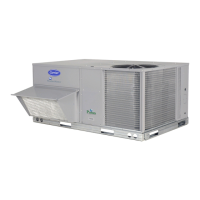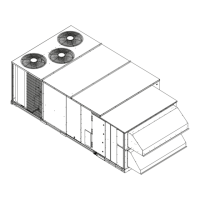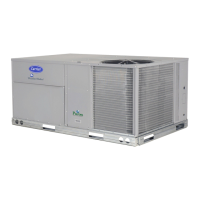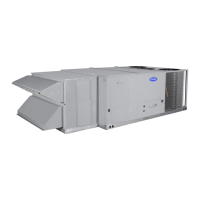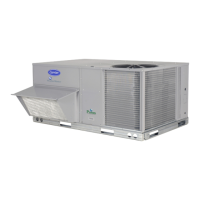66
Troubleshooting Units Equipped with EnergyX
®
System
COMPLETE ERV STOPPAGE
EnergyX
units are a combination of the base rooftop unit and
an integrated ERV. The ERV requires communication from the
rooftop for operation. This section covers ERV troubleshooting
only. For rooftop troubleshooting refer to the base unit’s Ser-
vice manual.
Complete ERV Stoppage
There are several conditions that can cause the ERV to shut-
down or appear to be shutdown:
• General power failure.
• Transformer’s circuit breaker tripped.
• ERV main power fuses blown.
• Communication failures.
• Active alarm on the base rooftop unit or the ERV prevent-
ing operation. Review alarms.
• Programmed occupancy schedule. Rooftop Unoccupied
• Rooftop indoor fan is off.
• The airflow sensor tubing connected to the incorrect high/
low sensor ports in the outside air.
CHECK ALARMS
The ERV has 4 possible alarms based on options installed in
the ERV. These alarms are described in detail below. They all
show up as a T418 alarm in the ComfortLink controller. Press-
ing enter and escape together on the scrolling marquee or Nav-
igator display will expand the text and provide the specific
alarm condition. There are 4 status points viewed under Oper-
ating Modes on the scrolling marquee or Navigator display
(Operating Modes
→OAU) for each alarm to help diagnose
which alarm caused the T418 in the ComfortLink controller.
These will all reset automatically when the situation has been
resolved.
T418 OAU Filter Dirty
The ERV’s dirty filter alarm should only occur if the optional
Filter Maintenance Switch is installed on the ERV. The dirty
filter alarm activates due to an increase in differential pressure
across the filters. The EXCB’s D16 LED will be turn on and
the OAU Dirty Filter Alarm point will be turned to on (Operat-
ing Modes
→OAU →ALM.2 = On). The alarm does not af-
fect unit operation but serves as a warning to replace the filters.
It will automatically reset when the pressure differential falls
below setpoint. Verify proper operation by partially blocking
airflow through the ERV filters and confirming that the alarm
does trip.
T418 OAU MOTOR FAILURE
This alarm indicates a motor problem in the ERV, any one of
the motors can trip this alarm (outside intake, exhaust and/or
the wheel motor). The intake and exhaust motors have build in
motor diagnostics and the wheel motor status is a field accesso-
ry. Since these are feed into the same alarm, it is important to
Table 24 — Pressure (psig) vs Voltage Drop Values for Suction Pressure Transducers
PRESSURE
(psi
g)
VOLTAGE
DROP
(
V
)
PRESSURE
(psi
g)
VOLTAGE
DROP
(
V
)
PRESSURE
(psi
g)
VOLTAGE
DROP
(
V
)
PRESSURE
(psi
g)
VOLTAGE
DROP
(
V
)
0 0.465 68 1.135 136 1.804 204 2.474
2 0.485 70 1.154 138 1.824 206 2.493
4 0.505 72 1.174 140 1.844 208 2.513
6 0.524 74 1.194 142 1.863 210 2.533
8 0.544 76 1.214 144 1.883 212 2.553
10 0.564 78 1.233 146 1.903 214 2.572
12 0.583 80 1.253 148 1.922 216 2.592
14 0.603 82 1.273 150 1.942 218 2.612
16 0.623 84 1.292 152 1.962 220 2.631
18 0.642 86 1.312 154 1.982 222 2.651
20 0.662 88 1.332 156 2.001 224 2.671
22 0.682 90 1.351 158 2.021 226 2.690
24 0.702 92 1.371 160 2.041 228 2.71
0
26 0.721 94 1.391 162 2.060 230 2.730
28 0.741 96 1.410 164 2.080 232 2.749
30 0.761 98 1.430 166 2.100 234 2.769
32 0.780 100 1.450 168 2.119 236 2.789
34 0.800 102 1.470 170 2.139 238 2.809
36 0.820 104 1.489 172 2.159 240 2.828
38 0.839 106 1.509 174 2.178 242 2.848
40 0.859 108 1.529 176 2.198 244 2.868
42 0.879 110 1.548 178 2.218 246 2.887
44 0.898 112 1.568 180 2.237 248 2.907
46 0.918 114 1.588 182 2.257 250 2.927
48 0.938 116 1.607 184 2.277 252 2.946
50 0.958 118 1.62
7 186 2.297 254 2.966
52 0.977 120 1.647 188 2.316 256 2.986
54 0.997 122 1.666 190 2.336 258 3.005
56 1.017 124 1.686 192 2.356 260 3.025
58 1.036 126 1.706 194 2.375 262 3.045
60 1.056 128 1.726 196 2.395 264 3.065
62 1.076 130 1.745 198 2.415 266 3.084
64 1.095 132 1.765 200 2.434 268 3.104
66 1.115 134 1.785 202 2.454 270 3.124
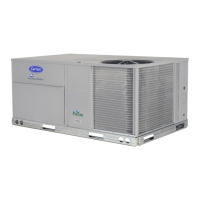
